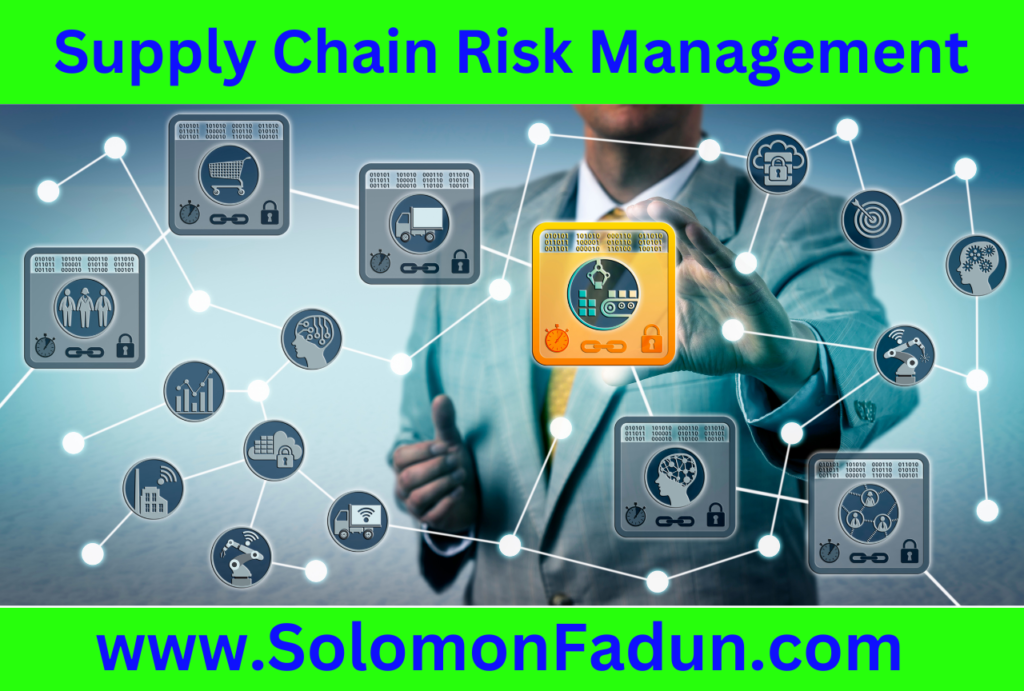Supply Chain Risk &
Supply Chain Risk Management

This post discusses supply chain risk and supply chain risk management. In this post, you will understand the meaning of supply chain, supply chain risk and the management of supply chain risks.
WHAT IS A SUPPLY CHAIN?
A supply chain is a network between a company and its suppliers to produce and distribute a specific product to the final buyer. A supply chain is a business’s activity to deliver goods or services to its consumers. This network includes activities, people, entities, information, and resources. The supply chain also represents the steps to get the product or service from its original state to the customer.
Companies develop supply chains to reduce costs and remain competitive in the business landscape. A supply chain is an entire system of producing and delivering a product or service, from sourcing the raw materials to the final delivery of the product or service to end users. The supply chain lays out all aspects of the production process, including the activities involved, information communicated, natural resources processed into valuable materials, human resources, and other components that go into the finished product or service.
WHY SHOULD A COMPANY UNDERSTAND ITS SUPPLY CHAIN?
A supply chain risk management plan is a strategy to speed response to as many circumstances as possible to minimise disruptions to the supply chain if they occur. A supply chain involves a series of steps to get a product or service to the customer. The measures include moving and transforming raw materials into finished products and transporting and distributing the products to the end user. The entities involved in the supply chain have producers, vendors, warehouses, transportation companies, distribution centres, and retailers.
A supply chain is critical in performing an external analysis in a strategic planning process. Laying out the supply chain helps a company define its market and decide where it wants to be. In developing corporate-level strategies, a company often needs to determine whether to operate a single line of business or enter other related or unrelated industries. Each stage of a supply chain is a different industry, for example, raw material extraction and manufacturing. The supply chain enables a company to understand other parties involved in all stages, thereby providing insights into the attractiveness or competitiveness in industries the company might want to enter.
STAGES OF A SUPPLY CHAIN
In its simplest form, stages in supply chain areas are depicted within Porter’s Value Chain. Porter’s Value Chain is a valuable strategic management tool because it categorises business activities into five parts. Porter’s value chain involves five primary activities: inbound logistics, operations, outbound logistics, marketing and sales, and service. Hence, Porter’s value chain can be used as a guide to a supply chain structure which consists of 4 major stages: (1) logistics, (2) operations, (3) marketing and sales, and (4) services.
SUPPLY CHAIN MANAGEMENT
The need for supply chain management has never been more popular as more companies are handing over their manufacturing processes to external supply networks that operate nationally or globally. Supply chain management is crucial because an optimised supply chain results in lower costs and a faster production cycle. The main goal of supply chain management is to look holistically at the entire supply chain from supplier to consumer and review three core areas of people, processes, and systems to maximise value from all activities.
Supply chain management involves managing supply chain activities to maximise customer value and achieve sustainable competitive advantage. It represents a conscious effort by the supply chain firms to develop and run supply chains effectively and efficiently. Supply chain activities cover everything from product development, sourcing, production, logistics, and the information systems needed to coordinate these activities.
Organisations that comprise the supply chain are linked through physical and information flows.
Physical Flows involve transforming, moving, and storing goods and materials. They are the most visible supply chain piece as important as the information flow.
Information Flows: allow the various supply chain partners to coordinate their long-term plans and control the day-to-day flow of goods and materials up and down the supply chain.
IMPORTANCE OF SUPPLY CHAIN MANAGEMENT
Supply chain management is a hefty task with hefty rewards. Here are some ways a well-executed supply chain management can benefit a business or project:
1. Keeps businesses competitive
2. Paces with technology
3. Creates productive environments
4. Proactive strategy
5. Satisfies customers
6. Reduces operations costs
NOMENCLATURES OF SUPPLY CHAIN MANAGEMENT ROLES
Nomenclatures of supply chain roles vary from firm to firm. Three terminologies are commonly used for supply chain roles to describe the head of supply chain operations in business organisations: Chief Procurement Officer, Chief Logistics Officer, and Supply Chain Manager.
SUPPLY CHAIN RISKS
Supply chain risk management refers to the process by which businesses take strategic steps to identify, assess, and mitigate risks within their end-to-end supply chain. Internal and external risks can disrupt a firm’s supply chain, so it is essential to understand the difference between internal and external supply chain risks.
EXTERNAL SUPPLY CHAIN RISKS
These global supply chain risks emanate outside an organisation. Some of the significant external supply chain risks include:
- Demand Risks
- Supply Risks
- Environmental Risks
- Business Risks
INTERNAL SUPPLY CHAIN RISKS
This refers to any supply chain risk factors within a firm’s control, which can be identified and monitored using supply chain risk assessment software, robust analytics programmes, and the Internet of Things (IoT) capabilities.
Internal supply chain risks include:
- Manufacturing Risks
- Business Risks
- Planning and Control Risks
- Mitigation and Contingency Risks
SOURCES OF SUPPLY CHAIN RISKS
A supply chain faces different risk types, including organisational, operational, strategic, commercial, and external risk. Nevertheless, four main sources or channels of risk that disrupt the flow of the supply chain:
- Price risks
- Quality risk
- Delivery risk
- Reputation risk
SUPPLY CHAIN RISK MANAGEMENT
Supply chain risk management entails taking the necessary steps to identify, assess, and mitigate the risks of an organisation’s supply chain. A sound supply chain risk management strategy helps a firm operate more efficiently to reduce costs and enhance customer service. Supply chain management refers to how organisations manage the flow of their goods, including all the processes involved in transforming raw materials into finished products.
Supply chain management includes the planning and executing activities around sourcing, procurement, conversion and all the logistics management functions. Good supply chain risk management enhances a firm’s operations. Risk management aims to prevent issues and provide loss mitigation if the risk eventually occurs. A significant reason why companies implement global supply chain management strategies is to boost their competitive advantage. Sound supply chains can assist a business in improving the quality of risk, safety, business continuity, and reputation.
BENEFITS OF SUPPLY CHAIN RISK MANAGEMENT
Benefits of supply chain risk management include:
- Strategic competitive advantage through an agile supply chain.
- Outperforming competitors are affected by the same shared risks, thus boosting market share when a common risk occurs.
- Supporting optimal supply chain design by reducing uncertainty and strengthening relationships and trust to minimise risk.
- Ensures detecting, optimising, and reducing risk exposure and cost compared to competing for supply chains.
- Operating and continuously improving a resilient supply chain.
- Safeguards the image of a company and improves customers satisfaction,
- Facilitates organisations’ self-assessment and certification against international standards to meet safety rules and regulations.
FEATURES OF SUCCESSFUL SUPPLY CHAIN RISK MANAGEMENT
A key attribute of successful SCRM is that suppliers can demonstrate that they apply the principles of good governance. These include providing qualifications, references, competence, quality, reliability, corporate social responsibility and environmental and security compliance.
Features of a successful supply chain risk management include:
1) Stimulates Many Supplies Chain Best Practices
2) Early Detection of Risk through Fluid Communication
3) Ability to Respond to Unexpected Events
4) Maintaining Business Operations
SUPPLY CHAIN RISK MANAGEMENT PROCESS
Supply chain risk management consists of five basic steps:
- Identification of business supply chain risks,
- Prioritisation of supply chain risks,
- Develop a supply chain risk management plan,
- Mitigate supply chain risks, and
- Monitor and review the supply chain risk management plan.
SUPPLY CHAIN RISK MANAGEMENT STRATEGIES
Identifying and prioritising risks is only helpful if the company develop strategies to mitigate the risks. There are several types of supply chain risk management strategies.
Here are ten types of supply chain risk management strategies:
1. PPRR RISK MANAGEMENT MODEL: Global supply chains, especially retailers, typically use the PPRR strategy. PPRR stands for Prevention, Preparedness, Response and Recovery.
2. MANAGE ENVIRONMENTAL RISKS: Businesses must understand how to manage environmental risks.
3. MITIGATE CYBER SUPPLY CHAIN RISKS: Software and other digital technologies that use the internet to streamline supply chain processes can be helpful. However, they also introduce cyber threats like viruses, hackers, phishing, and malware.
4. ANALYSE SUPPLIERS’ FINANCIAL STABILITY: Before an organisation commits to a supplier relationship, it should use a credit rating agency to generate predictive stability reports based on the potential vendor’s financial reputation.
5. MONITOR FREIGHT CARRIER METRICS: Retailers must ensure their product shipments arrive on time to meet deadlines and keep the remaining supply chain processes scheduled.
6. IMPLEMENT A COMPREHENSIVE LOGISTIC PLAN: Retailers need to develop a logistics contingency plan to ensure that operations can continue seamlessly if there is an unexpected disruption in the supply chain.
7. TRAIN EMPLOYEES TO ANTICIPATE RISKS: Management should be one of many groups of staff that can identify and prepare for risks.
8. CONTINUOUSLY MONITOR RISKS: Once the supply chain management strategy has been implemented, management must continue to monitor operations to ensure their long-term effectiveness.
9. MODEL DATA TO DEFINE RISKS SCENARIOS: Businesses can forecast potential risks by equipping the supply chain with predictive analytics and data modelling.
10. MANAGE IMPACTS ASSOCIATED WITH SUPPLY CHAIN RISKS: Risk prevention is a robust risk management strategy, but no amount of preparation can prevent a risk from occurring. Some events, e.g., natural disasters, cannot be stopped.
See a video on Supply Chain Risk and Supply Chain Risk Management: https://youtu.be/Q35AsGJmCAM

VIDEO TIMESTAMPS
00:00 – Introduction
01:15 – What is a supply chain?
02:30 – Why should a company understand its supply chain?
03:56 – Stages of a supply chain
04:42 – Examples of supply chains
05:21 – Generic and e-commerce supply chains
06:12 – Supply chain of an e-commerce company
07:34 – Supply chain management
11:01 – Importance of supply chain management
13:31 – Nomenclatures of supply chain management roles
15:33 – Supply chain risks
15:58 – External supply chain risks
18:18 – Internal supply chain risks
21:01 – Sources of supply chain risks
24:36 – Supply chain risk management
26:45 – Importance of supply chain risk management
28:15 – Features of successful supply chain risk management
31:19 – Steps of supply chain risk management process
46:05 – Supply chain risk management strategies
56:47 – Conclusion

